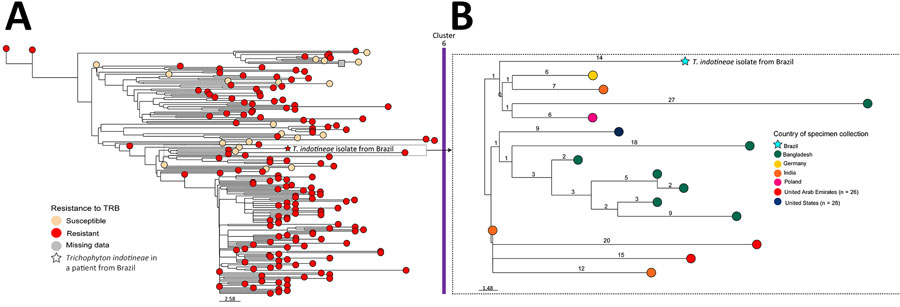Volume 31, Number 5—May 2025
Research Letter
Trichophyton indotineae Infection, São Paulo, Brazil, 2024
Figure 2

Figure 2. Trichophyton indotineae phylogenetic tree analysis by terbinafine susceptibility profile and country of origin for T. indotineae infection, São Paulo, Brazil, 2024. A) Neighbor-joining phylogenetic tree, which includes terbinafine-resistant and -susceptible T. indotineae isolates belonging to cluster 6. Isolates were considered terbinafine resistant if they had a missense point mutation in the squalene epoxidase (SQLE) gene for Trichophyton spp. linked to terbinafine resistance (5,6). B) Subcluster containing the isolate from the patient in Brazil. Among the 12 isolates in that subcluster, 5 resistant isolates, including an isolate from Germany, had the SQLE substitution F397L. Branch lengths represent the single-nucleotide polymorphism distance between isolates, and leaf colors correspond to the different countries in which each specimen was collected. The neighbor-joining tree and map were visualized together with each sample’s metadata using Microreact version 252 (https://docs.microreact.org). Scale bar represents number of single-nucleotide polymorphisms. TRB, terbinafine.
References
- Uhrlaß S, Verma SB, Gräser Y, Rezaei-Matehkolaei A, Hatami M, Schaller M, et al. Trichophyton indotineae—an emerging pathogen causing recalcitrant dermatophytoses in India and worldwide—a multidimensional perspective. J Fungi (Basel). 2022;8:757. DOIPubMedGoogle Scholar
- Caplan AS, Todd GC, Zhu Y, Sikora M, Akoh CC, Jakus J, et al. Clinical course, antifungal susceptibility, and genomic sequencing of Trichophyton indotineae. JAMA Dermatol. 2024;160:701–9. DOIPubMedGoogle Scholar
- Normand AC, Moreno-Sabater A, Jabet A, Hamane S, Cremer G, Foulet F, et al. MALDI-TOF mass spectrometry online identification of Trichophyton indotineae using the MSI-2 application. J Fungi (Basel). 2022;8:1103. DOIPubMedGoogle Scholar
- Arendrup MC, Kahlmeter G, Guinea J, Meletiadis J; Subcommittee on Antifungal Susceptibility Testing (AFST) of the ESCMID European Committee for Antimicrobial Susceptibility Testing (EUCAST). How to: perform antifungal susceptibility testing of microconidia-forming dermatophytes following the new reference EUCAST method E.Def 11.0, exemplified by Trichophyton. Clin Microbiol Infect. 2021;27:55–60. DOIPubMedGoogle Scholar
- De Paepe R, Normand AC, Uhrlaß S, Nenoff P, Piarroux R, Packeu A. Resistance profile, terbinafine resistance screening and MALDI-TOF MS identification of the emerging pathogen Trichophyton indotineae. Mycopathologia. 2024;189:29. DOIPubMedGoogle Scholar
- Saunte DML, Hare RK, Jørgensen KM, Jørgensen R, Deleuran M, Zachariae CO, et al. Emerging terbinafine resistance in Trichophyton: clinical characteristics, squalene epoxidase gene mutations, and a reliable EUCAST method for detection. Antimicrob Agents Chemother. 2019;63:e01126–219. DOIPubMedGoogle Scholar
- American Academy of Dermatology Association. Preventing and treating Trichophyton indotineae [cited 2024 Dec 17]. https://www.aad.org/member/clinical-quality/clinical-care/emerging-diseases/dermatophytes/preventing-treating-trichophyton-indotineae
- Khurana A, Sharath S, Sardana K, Chowdhary A. Clinico-mycological and therapeutic updates on cutaneous dermatophytic infections in the era of Trichophyton indotineae. J Am Acad Dermatol. 2024;91:315–23. DOIPubMedGoogle Scholar
- Falci DR, Pasqualotto AC. Clinical mycology in Latin America and the Caribbean: A snapshot of diagnostic and therapeutic capabilities. Mycoses. 2019;62:368–73. DOIPubMedGoogle Scholar
- Lockhart SR, Smith DJ, Gold JAW. Trichophyton indotineae and other terbinafine-resistant dermatophytes in North America. J Clin Microbiol. 2023;61:
e0090323 . DOIPubMedGoogle Scholar